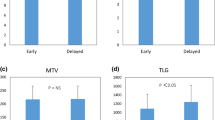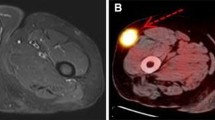Abstract
Objective
Positron emission tomography (PET) with 2-deoxy-2-[18F]fiuoro-D-glucose (18F-FDG) has been used for the evaluation of soft-tissue tumors. However, the range of accumulation of18F-FDG for malignant soft-tissue lesions overlaps with that of benign lesions. The aim of this study is to investigate the usefulness of delayed18F-FDG PET imaging in the differentiation between malignant and benign soft-tissue tumors.
Methods
Fifty-six patients with soft-tissue tumors underwent whole body18F-FDG PET scan at 1 hour (early scan) and additional scan at 2 hours after injection (delayed scan). The standardized uptake value (SUVmax) of the tumor was determined, and the retention index (RI) was defined as the ratio of the increase in SUVmax between early and delayed scans to the SUVmax in the early scan. Surgical resection with histopathologic analysis confirmed the diagnosis.
Results
Histological examination proved 19 of 56 patients to have malignant soft-tissue tumors and the rest benign ones. In the scans of all 56 patients, there was a statistically significant difference in the SUVmax between malignant and benign lesions in the early scan (5.50 ± 5.32 and 3.10 ± 2.64, respectively, p < 0.05) and in the delayed scan (5.95 ± 6.40 and 3.23 ± 3.20, respectively, p < 0.05). The mean RI was not significantly different between malignant and benign soft-tissue tumors (0.94 ± 23.04 and -2.03 ± 25.33, respectively).
Conclusions
In the current patient population, no significant difference in the RI was found between malignant and benign soft-tissue lesions. Although the mean SUVmax in the delayed scan for malignant soft-tissue tumors was significantly higher than that for benign ones, there was a marked overlap. The delayed18F-FDG PET scan may have limited capability to differentiate malignant soft-tissue tumors from benign ones.
Similar content being viewed by others
References
Strauss LG, Conti PS. The applications of PET in clinical oncology.J Nucl Med 1991; 32 (4): 623–648; discussion 49-50.
Aoki J, Watanabe H, Shinozaki T, Takagishi K, Tokunaga M, Koyama Y, et al. FDG-PET for preoperative differential diagnosis between benign and malignant soft tissue masses.Skeletal Radiol 2003; 32 (3): 133–138.
Kern KA, Brunetti A, Norton JA, Chang AE, Malawer M, Lack E, et al. Metabolic imaging of human extremity musculoskeletal tumors by PET.J Nucl Med 1988; 29 (2): 181–186.
Hustinx R, Smith RJ, Benard F, Rosenthal DI, Machtay M, Farber LA, et al. Dual time point fluorine-18 fluorodeoxy-glucose positron emission tomography: a potential method to differentiate malignancy from inflammation and normal tissue in the head and neck.Eur J Nucl Med 1999; 26 (10): 1345–1348.
Kubota K, Itoh M, Ozaki K, Ono S, Tashiro M, Yamaguchi K, et al. Advantage of delayed whole-body FDG-PET imaging for tumour detection.Eur J Nucl Med 2001; 28 (6): 696–703.
Matthies A, Hickeson M, Cuchiara A, Alavi A. Dual time point18F-FDG PET for the evaluation of pulmonary nodules.J Nucl Med 2002; 43 (7): 871–875.
Nakamoto Y, Higashi T, Sakahara H, Tamaki N, Kogire M, Doi R, et al. Delayed (18)F-fluoro-2-deoxy-D-glucose positron emission tomography scan for differentiation between malignant and benign lesions in the pancreas.Cancer 2000 15; 89 (12): 2547–2554.
Alenius S, Ruotsalainen U. Bayesian image reconstruction for emission tomography based on median root prior.Eur J Nucl Med 1997; 24 (3): 258–265.
Adler LP, Blair HF, Makley JT, Williams RP, Joyce MJ, Leisure G, et al. Noninvasive grading of musculoskeletal tumors using PET.J Nucl Med 1991; 32 (8): 1508–1512.
Griffeth LK, Dehdashti F, McGuire AH, McGuire DJ, Perry DJ, Moerlein SM, et al. PET evaluation of soft-tissue masses with fluorine-18 fluoro-2-deoxy-d-glucose.Radiology 1992; 182 (1): 185–194.
Hamada K, Ueda T, Higuchi I, Inoue A, Tamai N, Myoi A, et al. Peripheral nerve schwannoma: two cases exhibiting increased FDG uptake in early and delayed PET imaging.Skeletal Radiol 2005; 34 (1): 52–57.
Lodge MA, Lucas JD, Marsden PK, Cronin BF, O’ Doherty MJ, Smith MA. A PET study of18FDG uptake in soft tissue masses.Eur J Nucl Med 1999; 26 (1): 22–30.
Author information
Authors and Affiliations
Rights and permissions
About this article
Cite this article
Enomoto, K., Higuchi, I., Hatazawa, J. et al. Evaluation of delayed18F-FDG PET in differential diagnosis for malignant soft-tissue tumors. Ann Nucl Med 20, 671–675 (2006). https://doi.org/10.1007/BF02984678
Received:
Accepted:
Issue Date:
DOI: https://doi.org/10.1007/BF02984678




